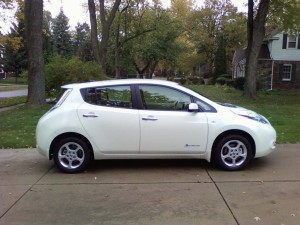
Automakers could build more electric vehicles such as the Nissan Leaf to offset gas-powered vehicles. New fuel economy rules for the 2017-25 model years introduced Tuesday are projected to save nearly $6,600 worth of fuel per vehicle, offset by an extra $2,000 per car in new technology to improve fuel economy.
The U.S. Environmental Protection Agency and U.S. Department of Transportation unveiled their joint proposal that increases fuel efficiency requirements to 54.5 mpg if all reductions were made through fuel economy improvements.
The improvements would save consumers an estimated average of up to $6,600 in fuel costs over the lifetime of a 2025 vehicle for a net lifetime savings of up to $4,400 after factoring in related increases in vehicle cost. Overall, the net benefit to society from this rule would total more than $420 billion over the lifetime of the vehicles sold in from 2017-25, the government said.
“Today’s announcement is the latest in a series of executive actions the Obama Administration is taking to strengthen the economy and move the country forward because we can’t wait for Congressional Republicans to act,” according to the release.
But the National Automotive Dealers Association said that the new standard could end up hurting the environment.
So what will these new vehicles be like and what technologies will automakers use to reach these goals? Here are some predictions:
- Lightweighting technologies: Automakers will reduce steel content, replacing it with exotic materials such as carbon fiber, magnesium and more aluminum.
- Electric vehicles: Automakers will build more electric vehicles, which will offset their gasoline-powered counterparts.
- Hybridization: Virtually all cars will have some degree of hybridization, even if it is just “hybrid light,” such as the eAssist system on some General Motors vehicles.
- Start/stop: First introduced on hybrids, this technology will become standard on almost every car sold.
- Smaller cars: While the trend for many years has been ever-increasing size and weight of car models, automakers will work to reduce vehicle size.
- New types of internal combustion engines: Companies, such as EcoMotors are working on new types of internal combustion engines that promise increased efficiency.
- Diesel: The current generation of clean diesels provide better fuel economy than gas engines, but the technology to clean them up is expensive. But biodiesel would count toward reductions in fossil fuel use.
The proposal is projected to save Americans more than $1.7 trillion at the pump, or more than $8,000 per vehicle by 2025. These combined actions also will reduce America’s dependence on oil by an estimated 12 billion barrels, and, by 2025, reduce oil consumption by 2.2 million barrels per day – enough to offset almost a quarter of the current level of our foreign oil imports. Taken together, these actions will also slash 6 billion metric tons in greenhouse gas emissions over the life of the programs, the agencies said.
“These unprecedented standards are a remarkable leap forward in improving fuel efficiency, strengthening national security by reducing our dependence on oil, and protecting our climate for generations to come,” said U.S. Transportation Secretary Ray LaHood. “We expect this program will not only save consumers money, it will ensure automakers have the regulatory certainty they need to make key decisions that create jobs and invest in the future.”
But NADA claimed in its release that the upgrades would actually add $3,000 to vehicle costs, which it believes could reduce turnover of the U.S. vehicle fleet, delaying environmental improvements.
“This regulation gambles that millions of consumers will be able to afford thousands more for generally smaller, more expensive vehicles that may not meet their needs,” NADA said. “This policy is contrary to what most consumers are actually buying today, despite the wide availability of more fuel efficient models.”

“Today’s announcement is the latest in a series of executive actions the Obama Administration is taking to strengthen the economy and move the country forward because we can’t wait for Congressional Republicans to act,” according to the release.
Yes, the Campaigner in Chief and his czars have just done wonders to strengthen the economy. Real unemployment is 15-18%, more people have reached poverty level and are on food stamps and the federal debt has climbed to a record $15 trillion.
54.5 mpg? Good luck.